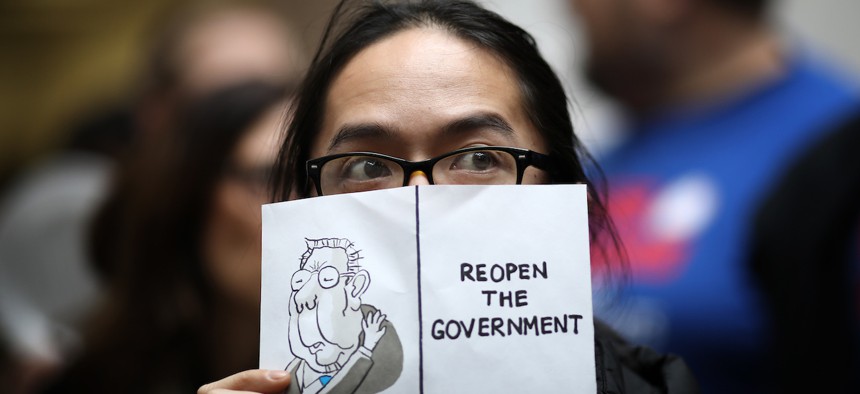
Furloughed federal workers and those aligned with them protest the partial government shutdown in the Hart Senate Office Building on Jan. 23, 2019. If House Republicans aren’t able to agree on a spending plan by Sept. 30, some federal employees will face another furlough. Win McNamee/Getty Images
See who would get furloughed in a shutdown this year
The Biden administration is planning to take a novel shutdown approach at some agencies.
With lawmakers struggling to come up with a plan to fund the government past Sept. 30, agencies are dusting off their shutdown plans.
In conjunction with the Office of Management and Budget, every agency in government maintains a contingency plan for a lapse in appropriations. That includes exactly which work it will continue to conduct despite not receiving annual funding, as well as which employees it will require to continue working to carry it out.
The White House, through OMB, maintains some latitude in the exact consequences of a shutdown. Federal employees funded through mechanisms other than annual appropriations, as well as those necessary to protect life and property, are considered either “exempted” or “excepted” and work throughout shutdowns on only the promise of backpay. The rest of employees are sent home on furlough without pay, though, following the record-setting 35-day shutdown in 2018 and 2019, those workers are now also guaranteed backpay. Different administrations have taken varying approaches in determining who gets furloughed and who works, with the Trump administration taking an unusually aggressive approach to keeping staff at work.
Accusing its predecessors of “weaponizing” shutdowns, Trump’s OMB instructed agencies to identify “carry-forward funding” and “transfer authority” to minimize the impact of shutdowns. That led to several agencies that in prior appropriations lapses sent home the vast majority of its workforce instead furloughing very few employees, though in some cases agencies were forced to increase the number of employees it furloughed as the shutdown dragged on.
Other agencies, meanwhile, began calling employees back to the office as the lengthy shutdown caused more scenarios to crop up that the administration deemed as exempted work.
Some agencies have already started planning for those contingencies. The Justice Department, for example, noted components may call some employees back to work "if the need for their services become critical," and may "furlough others as conditions change." The Homeland Security Department is planning to recall 1,400 employees if a shutdown drags on for more than five days.
OMB declined to comment on the record on the approach the Biden administration would take this year, though preliminary public shutdown plans show it will take a similar approach in aggressively instructing employees to continue working.
In the shutdown that began in December 2018, some agencies had already received full-year appropriations and were therefore unaffected by the funding lapse. About 850,00 federal employees were impacted and around 345,000 of those—or around 41%—were furloughed. The entire federal workforce is facing the threat of a shutdown this time around, and—according to the most up-to-date plans publicly available—the Biden administration plans to furlough about 737,000, or 34%, of them.
Some of that change in overall furlough rate is due to the agencies that were unaffected in 2018, though other variances are attributable to the Biden administration taking a different approach or the availability of new funds. At the Treasury Department, for example, the Internal Revenue Service is planning, according to a document posted to its website last year but recently scrubbed, to keep its entire workforce on board during a shutdown. Funding from the Inflation Reduction Act will make that possible, the agency said. Treasury’s furlough rate is now set to be just 2%, compared to 83% when funding lapsed in 2018.
The Small Business Administration is also anticipating a significantly different approach, projecting it will furlough just 17% of its staff in a shutdown this year compared to 65% in 2018. The Housing and Urban Development Department would send home 82% of its employees, compared to 95% in the last shutdown.
The National Science Foundation noted it will "use available carryover balances to continue daily operations," while Federal Emergency Management Agency Administrator Deanne Criswell said at the White House last week it can maintain all necessary staff funded through the Disaster Relief Fund.
On the other side of the spectrum, the Environmental Protection Agency, which initially furloughed virtually none of its employees in 2018 after it identified “carry-over funds” to stay open, is planning to send home 93% of its workers. The Federal Communications Commission did not furlough any employees in 2018 but is planning to send home 82% of them this time around.
The Biden administration’s hands may be more tied than in years past.
The Government Accountability Office, which enforces the Anti-Deficiency Act, the law that governs federal spending during shutdowns, ultimately found the Trump administration acted unlawfully during the 2018-2019 funding lapse. GAO said the Interior Department violated the law when it used recreation fees collected by the National Park Service to keep parks open and continue services such as trash collection and restroom maintenance. It also faulted the Agriculture Department for disbursing Supplemental Nutrition Assistance Program benefits early during the shutdown
The Trump administration's decisions tore "at the very fabric of Congress’s constitutional power of the purse,” said GAO, which threatened fines and imprisonment for officials who acted similarly in the future.
OMB has instructed agencies across government to update their shutdown contingency plans, though many have not yet publicly posted them. Government Executive took the most recently available plans to calculate furlough data, some of which were accessed via archived versions. In some cases, OMB is in the process of reviewing newer versions of agency plans. Agencies like the Interior Department and General Services Administration are not included in the below chart, as they have not posted updated plans since the Trump administration.
OMB will inform agencies of when to tell employees whether or not they are furloughed, which would be followed by formal furlough notices once a shutdown officially begins.








